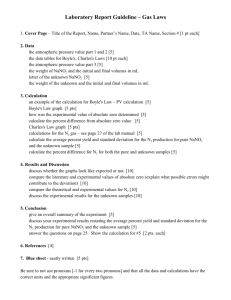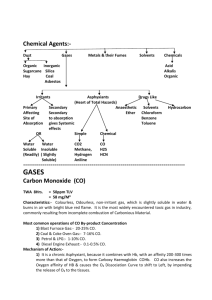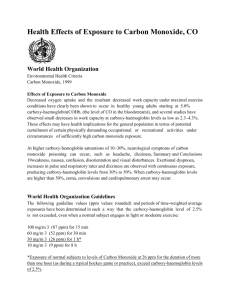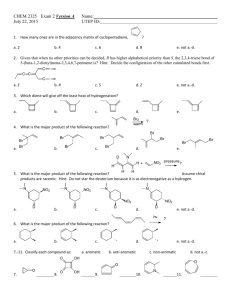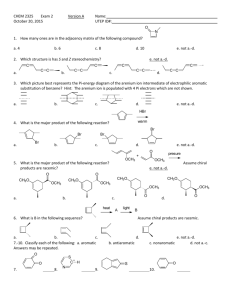Advance Journal of Food Science and Technology 6(3): 417-423, 2014
advertisement
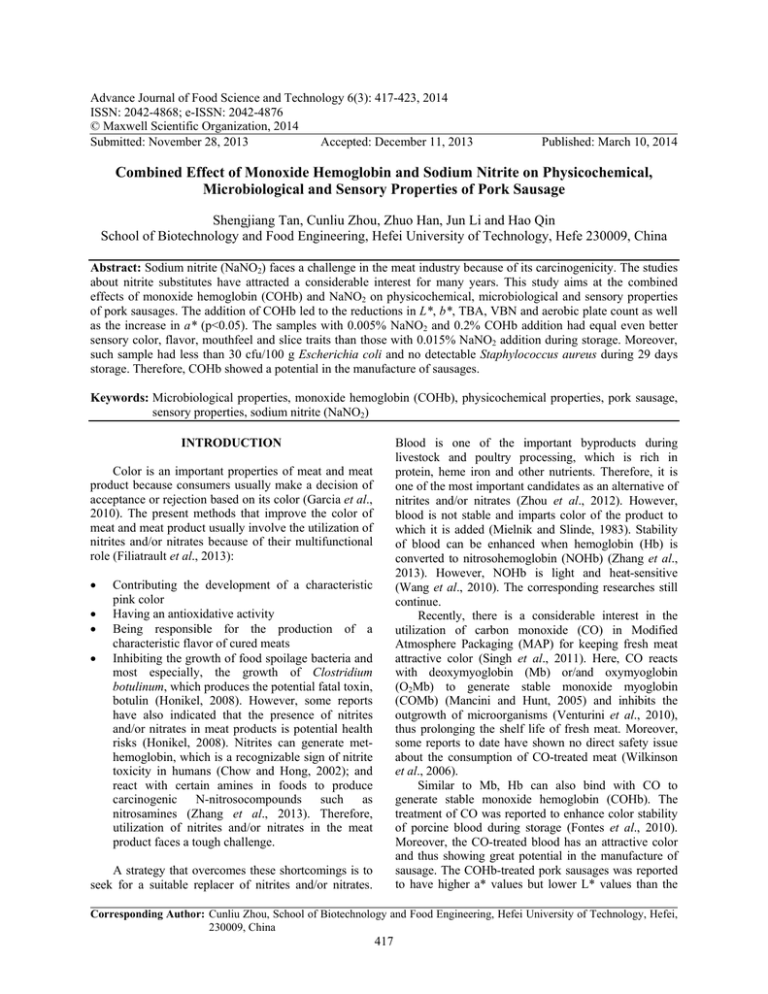
Advance Journal of Food Science and Technology 6(3): 417-423, 2014 ISSN: 2042-4868; e-ISSN: 2042-4876 © Maxwell Scientific Organization, 2014 Submitted: November 28, 2013 Accepted: December 11, 2013 Published: March 10, 2014 Combined Effect of Monoxide Hemoglobin and Sodium Nitrite on Physicochemical, Microbiological and Sensory Properties of Pork Sausage Shengjiang Tan, Cunliu Zhou, Zhuo Han, Jun Li and Hao Qin School of Biotechnology and Food Engineering, Hefei University of Technology, Hefe 230009, China Abstract: Sodium nitrite (NaNO2) faces a challenge in the meat industry because of its carcinogenicity. The studies about nitrite substitutes have attracted a considerable interest for many years. This study aims at the combined effects of monoxide hemoglobin (COHb) and NaNO2 on physicochemical, microbiological and sensory properties of pork sausages. The addition of COHb led to the reductions in L*, b*, TBA, VBN and aerobic plate count as well as the increase in a* (p<0.05). The samples with 0.005% NaNO2 and 0.2% COHb addition had equal even better sensory color, flavor, mouthfeel and slice traits than those with 0.015% NaNO2 addition during storage. Moreover, such sample had less than 30 cfu/100 g Escherichia coli and no detectable Staphylococcus aureus during 29 days storage. Therefore, COHb showed a potential in the manufacture of sausages. Keywords: Microbiological properties, monoxide hemoglobin (COHb), physicochemical properties, pork sausage, sensory properties, sodium nitrite (NaNO2) Blood is one of the important byproducts during livestock and poultry processing, which is rich in protein, heme iron and other nutrients. Therefore, it is one of the most important candidates as an alternative of nitrites and/or nitrates (Zhou et al., 2012). However, blood is not stable and imparts color of the product to which it is added (Mielnik and Slinde, 1983). Stability of blood can be enhanced when hemoglobin (Hb) is converted to nitrosohemoglobin (NOHb) (Zhang et al., 2013). However, NOHb is light and heat-sensitive (Wang et al., 2010). The corresponding researches still continue. Recently, there is a considerable interest in the utilization of carbon monoxide (CO) in Modified Atmosphere Packaging (MAP) for keeping fresh meat attractive color (Singh et al., 2011). Here, CO reacts with deoxymyoglobin (Mb) or/and oxymyoglobin (O2Mb) to generate stable monoxide myoglobin (COMb) (Mancini and Hunt, 2005) and inhibits the outgrowth of microorganisms (Venturini et al., 2010), thus prolonging the shelf life of fresh meat. Moreover, some reports to date have shown no direct safety issue about the consumption of CO-treated meat (Wilkinson et al., 2006). Similar to Mb, Hb can also bind with CO to generate stable monoxide hemoglobin (COHb). The treatment of CO was reported to enhance color stability of porcine blood during storage (Fontes et al., 2010). Moreover, the CO-treated blood has an attractive color and thus showing great potential in the manufacture of sausage. The COHb-treated pork sausages was reported to have higher a* values but lower L* values than the INTRODUCTION Color is an important properties of meat and meat product because consumers usually make a decision of acceptance or rejection based on its color (Garcia et al., 2010). The present methods that improve the color of meat and meat product usually involve the utilization of nitrites and/or nitrates because of their multifunctional role (Filiatrault et al., 2013): Contributing the development of a characteristic pink color Having an antioxidative activity Being responsible for the production of a characteristic flavor of cured meats Inhibiting the growth of food spoilage bacteria and most especially, the growth of Clostridium botulinum, which produces the potential fatal toxin, botulin (Honikel, 2008). However, some reports have also indicated that the presence of nitrites and/or nitrates in meat products is potential health risks (Honikel, 2008). Nitrites can generate methemoglobin, which is a recognizable sign of nitrite toxicity in humans (Chow and Hong, 2002); and react with certain amines in foods to produce carcinogenic N-nitrosocompounds such as nitrosamines (Zhang et al., 2013). Therefore, utilization of nitrites and/or nitrates in the meat product faces a tough challenge. A strategy that overcomes these shortcomings is to seek for a suitable replacer of nitrites and/or nitrates. Corresponding Author: Cunliu Zhou, School of Biotechnology and Food Engineering, Hefei University of Technology, Hefei, 230009, China 417 Adv. J. Food Sci. Technol., 6(3): 417-423, 2014 non COHb-treated ones (Zhou et al., 2012). However, the color of pork sausage treated with COHb alone was not uniform: its outer portion was relatively dark. Additionally, there is no report on the effects of COHb on other quality characteristics of meat products. We report the combined effects of COHb and NaNO2 on physicochemical, microbiological and sensory characteristics of pork sausage in this study. METASYNTHESIS Materials: Trichloroacetic acid and thiobarbituric acid were purchased from Shanghai Zhongshi Chemicals Corporation (Shanghai, China). Sodium citrate was purchased from Suzhou Chemical Reagent Co., Ltd. (Suzhou, China). Sulfuric acid, formic acid, HCl and NaOH were purchased from Shanghai Chemical Reagents Company (Shanghai, China). Magnesium oxide was purchased from Tianjin Bodi Chemical Corporation (Tianjin, China). Fine iodized salt (≥99.5%, food grade) was purchased from Anhui Salt Industry General Corporation (Hefei, China). Monosodium glutamate (food grade) was purchased from Shanghai Totole Food Co., Ltd. (Shanghai, China). Phosphate (food grade) was purchased from a local Hypermarket of the Carrefour Group. White pepper was purchased from Jinjiang Ayibo Food Industry and Trade Co. Ltd. (Jinjiang, China). Ginger powder was purchased from Shanghai Haomeijia Food Co., Ltd. (Shanghai, China). In addition, frozen pork legs were purchased from a local Hypermarket of the Carrefour Group. The proper amount of frozen pork legs was thawed for 24 h at 24°C. Subsequently, the thawed legs were removed of skin, bone, visible fat and connective tissue and then ground twice with a meat grinder (YEEKAI, MGB-120, Guangdong, China) fitted with a plate of 6 mm diameter holes. The proximate compositions of the ground meat were moisture 75.19±0.19%, protein 22.04±0.13%, fat 1.14±0.05% and ash 1.14 ±0.04% (all in triplicates). Methods: Preparation of monoxide hemoglobin (COHb): COHb was prepared according to the procedure described by Zhou et al. (2012). Specifically, 8.0 g sodium citrate (0.8%, m/v) was added to 1000 mL fresh porcine blood. The mixture was stirred for 1 min. Subsequently, the mixture was filtered with gauze. The filtrate was centrifuged with a CT15RT refrigerated centrifuge (Shanghai Tianmei Biochemical Engineering Equipment Co., Ltd., Shanghai, China) at the speed of 1,660 g for 10 min at 4°C. 335 mL Red Blood Cell (RBC) was obtained. The RBC was washed with 650 mL 0.9% (m/v) NaCl solution twice. CO was prepared by a reaction of concentrated sulfuric acid and formic acid at 85°C. The resulting CO was purified with a solution of 10% (m/v) NaOH and then introduced to saturate RBC with stirring at room temperature. Subsequently, the mixture was dehydrated by a freeze-drying process (ALPHA1-4LSC freeze dryer; Martin Christ, Osterode am Harz, Germany). The product was characterized by an analysis of Vis spectroscopy (not shown). Three characteristic peaks (411, 529 and 555 nm) were found. The product was proved to be COHb. Sausage preparation: The frozen trimmed lean tissue of pork legs was thawed for 24 h at 2-4°C and mixed with fresh pork backfat at a ratio of 19 to 1. The resulting mixture was ground with a chopper (YEEKAI, MGB-120, Guangdong, China). Six treatments were prepared according to the following formulation: A: control, without NaNO2 or COHb, B: 0.015% NaNO2, C: 0.1% COHb, D: 0.2% COHb, E: 0.005% NaNO2+0.2% COHb, F: 0.01% NaNO2+0.2% COHb. In addition, other additives were also added: 5% water, 2.5% sodium chloride, 0.015% monosodium glutamate, 0.02% ginger powder, 0.15% phosphates and 0.02% white pepper powder. The additives were added based on meat mixture. The meat mixture was stuffed into polyethylene casing (ø: 30 mm) and then stored at 4°C for 24 h. Each sample was approximately 20 g. The raw sausages were heated to 85 ± 1°C in a water bath for 40 min. Cooled with tap water, the cooked sausages without packaging were stored in a refrigerator (4°C) and analyzed at days of 1, 8, 15, 22 and 29. Color measurement: Color measurement was carried out according to the protocol described by Zhou et al. (2012). The color of pork sausage was measured with an automatic colorimeter WB-2000 IXA (Beijing Kangguang Instrument Co., Ltd, China). Specifically, the sausage samples were cut to cylinder (2.0-cm diameter, 1.0-cm high) and determined immediately. Six measurements for each of three replicates were expressed as L* value, a* value and b* value. The overall lightness or darkness was determined by L* value (0 = black, 100 = white). Red (positive = a+) and green (negative = a-) intensity represented the a* scale and yellow (positive = b+) and blue (negative = b-) intensity represented the b* scale. Measurement of TBA: TBA values were performed according to the procedure described by John et al. (2005) with some modifications (in triplicate). Specifically, 5 g meat sample was taken and mixed with 25 mL solution containing 0.375% thiobarbituric acid, 15% trichloroacetic acid and 0.25 mol/L HCl. The mixture was heated for 10 min in a boiling water bath (99±1°C) to develop a pink azo compound, cooled in tap water and then centrifuged (Model CT14RD, Shanghai Techcomp Ltd., China) at 2010 g for 25 min. The absorbance of the supernatant was measured with a spectrophotometer (model 722E, Spectrum of Shanghai, China) at 532 nm against a blank that contained all the 418 Adv. J. Food Sci. Technol., 6(3): 417-423, 2014 reagents minus the meat. The malonaldehyde (MDA) concentration was calculated using an extinction coefficient of 1.56×105/M/cm for the pink TBA-MDA pigment. The MDA concentration was converted to TBA number (mg MDA/kg meat sample) as follows: TBA No. (ppm) = sample A532×2.77. Measurement of VBN: VBN values were analyzed according to the procedure described in National Standard of China (GB/T5009.44-2003) with some modifications (in triplicate). To 10 g meat sample, 100 ml distilled water was added. The sample was homogenized for 2-5 min at 21,000 g and then placed for 30 min. The homogenate was filtered with filter paper for analysis. 5 mL filtrate was put into a distillation flask. To the filtrate, 5 mL magnesium oxide suspension (10 g/L) was added. The mixture was distilled using the microKjeldahl distillation apparatus (Auto K9840 Analyzer, Kjeltec, Beijing Changheng Rongchuang Technology Co., Ltd.). The distillate was collected for 3 min into 10 mL boric acid (20 g/L) containing five-six drops of mixed indicator (2 g/L methyl red indicator alcohol solution and 1 g/L methylene blue indicator aqueous solution). The solution was titrated by 0.01 mol/L HCl. The VBN in the sample in terms of milligrams of VBN per 100 g sausage can be given according to the following equation: X = 28000(V1-V2) ×c ÷ m where, X = VBN content of the sample (mg/l00 g) V1 = The consumption volume of HCl standard solution for titration of the sample (mL) V2 = The consumption volume of HCl standard solution for titration of the blank (mL) C = The actual concentration of HCl standard solution (mol/L) m = The mass of the sample (g) Microbiological analysis: Aerobic plate count, E. coli count and S. aureus count of two treatments (the control and the 0.005% NaNO2 and 0.2% COHb sample) were determined according to the protocol described by national food safety standard of China (GB 4789.22010). Specifically, 25 g samples stored for 1, 8, 15, 22 and 29 days were taken aseptically, transferred to sterile plastic pouches containing 225 mL 0.85% NaCl solution and then homogenized for 2 min at room temperature. Appropriate dilutions of samples (the samples stored for 1, 8 and 15 days were diluted to 100 times volume of the original volume, while the ones stored for 22 and 29 days were diluted to 1000 times volume of the original volume) were spread on triplicate agar plates and then incubated at 36±1°C for 48 h under anaerobic conditions. Aerobic plate count, E. coli count and S. aureus count were determined on Plate Count Agar (Beijing Aoboxing Biotechnology Co. Ltd., Beijing, China), E. coli chromogenic agar (Beijing Aoboxing Biotechnology Co. Ltd., Beijing, China) and S. aureus chromogenic agar (Beijing Aoboxing Biotechnology Co. Ltd., Beijing, China), respectively. Results were expressed as log10 numbers of colony forming units/gram (cfu/g). Three samples for each treatment were analyzed. Sensory evaluation: A sensory panel consisted of 9 food science and engineering-majored master graduate student, of Hefei University of Technology. The criteria for the panel were: 4 males and 5 females, age between 18 and 22, normal or superior visual and taste acuity. The panelists had grasped the knowledge of food sensory evaluation and were willing to evaluate the color, flavor, mouthfeel and slice traits of the COHbtreated pork sausages and also those throughout refrigerated storage. Before conducting the experiment, the panelists were trained for the development of a sensory memory with respect to each descriptive term throughout refrigerated storage. The method described by Wang and Zhao (2008) was used to prepare the list of descriptive terms, the pork sausage samples being presented in pairs for the panelists to list the differences and similarities. By consensus among the panel, the following scales were used: color (10-8 = red and bright, 7-5 = grey or slight red but still acceptable, 4-1 = excessive red and dark, not acceptable); flavor (10-8 = flavor, 7-5 = moderately off-odor but still acceptable, 41 = strongly off-odor and not acceptable); mouthfeel (10-8 = good, 7-5 = moderate, 4-1 = poor) and slice traits (10-8 = solid and smooth; 7-5 = slightly softening along peripheral and slight fissures, 4-1 = strongly softening). The pork sausage samples were stored under refrigeration (4±1°C) until the moment of evaluation to the panelists. The testing procedure was performed in the room where is used for sensory evaluation. Three samples for each treatment were coded with random numbers. The pork sausage samples in polyethylene casing during after 1, 8, 15, 22 and 29 days of refrigerated storage were submitted to each panelist and then opened and evaluated individually. All the sensory evaluations were carried out at room temperature and under natural light. Statistics analysis: Statistical analysis was performed by Excel 2003 (Microsoft official Excel 2003 for Windows). The data were expressed as mean±standard deviation (SD). Analysis of Variance (ANOVA) was introduced to determine the significance of samples at p<0.05 level. When a significant effect was obtained, Duncan’s multiple range tests were used to compare sample means. 419 Adv. J. Food Sci. Technol., 6(3): 417-423, 2014 RESULTS AND DISCUSSION Color: The addition of COHb resulted in the reductions of L* values (p<0.05) (Fig. 1). The samples that had more COHb added had lower L* values (p<0.05). The changes in L* values resulted possibly from the changes of Hb during storage. Mielnik and Slinde (1983) observed that blood imparted the dark color of the sausages to which it was added. Slinde (1987) speculated that color of black salami sausage was ascribed to the dissociation of heme from Hb. Therefore, it was possible that some Hb presenting in the added COHb dissociated to set free heme, thereby leading to the reduction of L* values. The addition of NaNO2 also decreased L* values (p<0.05). In comparison to the samples treated with 0.2% COHb alone, the treatment with a combination of COHb and NaNO2 had no significant influence on L* values (p>0.05). The addition of COHb or NaNO2 caused the increase of a* values (p<0.05). The effects of COHb on a* values depended on its levels: the samples that had more COHb added tended to have higher a* values. Zhou et al. (2012) observed that both COHb and COMb were the chemical components of the pigments extracted from the 0.4% COHb non-cooked sausages. Therefore, they speculated that the changes in a* values of the COHb-treated samples resulted possibly from COHb or/and COMb formed by a transfer of CO from Hb to Mb. In addition, the combined treatments had higher a* values than the single ones, indicating that COHb and NaNO2 affected synergistically a* values. The combined effects of COHb and NaNO2 on a* values might be ascribed to the formation of NOHb since NaNO2 can react with Hb to generate NOHb (Zhang et al., 2013). The change tendency of b* values was similar to that of L* values, that is, the addition of COHb, NaNO2 or a combination of COHb and NaNO2 decreased b* values, significantly (p<0.05). The samples that had more COHb added tended to have lower b* values. Also, COHb and NaNO2 did not affect Fig. 1: The changes in color of various treatments during storage; A: control, without NaNO2 or CO-Hb; B: 0.015% NaNO2; C: 0.1% CO-Hb; D: 0.2% CO-Hb; E: 0.005% NaNO2 +0.2% CO-Hb; F: 0.01% NaNO2+0.2% CO-Hb; Error bars refer to the standard deviation obtained from three analyses 420 Adv. J. Food Sci. Technol., 6(3): 417-423, 2014 Fig. 4: The changes in aerobic plate count of the different treatments during storage; Error bars refer to the standard deviation obtained from three analyses Fig. 2: The changes in TBA of various treatments during storage; A: control, without NaNO2 or CO-Hb; B: 0.015% NaNO2; C: 0.1% CO-Hb; D: 0.2% CO-Hb; E: 0.005% NaNO2+0.2% CO-Hb; F: 0.01% NaNO2 + 0.2% CO-Hb; Error bars refer to the standard deviation obtained from three analyses Fig. 3: The changes in TBA of various treatments during storage; A: control, without NaNO2 or CO-Hb; B: 0.015% NaNO2; C: 0.1% CO-Hb, D: 0.2% CO-Hb; E: 0.005% NaNO2 + 0.2% CO-Hb; F: 0.01% NaNO2 + 0.2% CO-Hb; Error bars refer to the standard deviation obtained from three analyses synergistically b* values. The results indicated that the samples treated with COHb, or a combination of COHb and NaNO2 were more reddish, dark and yellowish in comparison to the controls. L* values, a* values and b* values decreased significantly during storage (p<0.05) in all cases. These results revealed the following facts: Decomposition and/or oxidation of pigments in the sausages had occurred The samples became darker and less reddish during storage. Additionally, for the different treatments, the changes in a* and L* values had different speed. The samples treated with COHb were slower than the controls, but faster than the ones treated with NaNO2 or a combination of COHb and NaNO2. These results indicated that the samples treated with NaNO2 or a combination of COHb and NaNO2 enhanced color stability. TBA: Figure 2 summarized the changes in TBA values during storage. TBA value is an indicator of lipid oxidation (Tan et al., 2007). As expected, TBA values increased significantly (p<0.05) during storage in all cases, showing that lipid oxidation occurred. The addition of COHb led to the significant reductions of TBA value in the presence or absence of NaNO2 (p<0.05). Such behaviors of COHb are similar to those of NOHb (Shi and Kong, 2009). The samples that had more COHb added tended to have lower TBA values, but the differences of TBA values were not so high to be significant (p>0.05). Also, the addition of NaNO2 caused the significant reduction of TBA value (p<0.05), which was in agreement with the prior reports (Shi and Kong, 2009). The present results showed that the treatments with NaNO2, COHb, or a combination of NaNO2 and COHb could protect lipid from oxidation. VBN: It was observed that VBN values of all the treatments increased over the storage time (Fig. 3). VBN value is an indication of protein degradation (Tan et al., 2007). Therefore, the results revealed that protein degradation had occurred during storage. The controls had higher VBN values than the treatments with NaNO2, COHb, or a combination of NaNO2 and COHb (p<0.05). The present results indicated that the treatments with NaNO2, COHb, or a combination of NaNO2 and COHb could delay protein degradation. NOHb is also reported to decrease the VBN values meat batters (Zhang et al., 421 Adv. J. Food Sci. Technol., 6(3): 417-423, 2014 2013). In addition, all the samples in this study did not exceed 20 mg/100 g, which is the value that is often described as the level necessary to detect meat spoilage (Tan et al., 2007). Microbiological analysis: The results of microbiological analysis were illustrated in Fig. 4. As expected, aerobic plate count increased with storage time. The 0.005% NaNO2 and 0.2% COHb samples had significantly lower aerobic plate counts than the controls during storage (p<0.05). These results showed that the combined treatment was effective in inhibiting aerobic growth. E. coli of all the samples in this study did not exceed 30 cfu/100 g during storage, which is the value that is often described as the level necessary to detect microbiological safety for sausage product (national food safety standard of China, GB 4789.2-2010). Differed from the controls, the samples that had 0.005% NaNO2 and 0.2% COHb added were not detected in S. aureus when the storage time was extended to 29 days, indicating that a combination of NaNO2 and COHb was effective in inhibiting S. aureus growth. Sensory characteristics: It is well known that NaNO2 can develop a characteristic pink color and is responsible for the production of characteristic flavor of cured meats (Filiatrault et al., 2013). It was found that the addition of NaNO2 increased significantly sensory color scores in the present study (p<0.05) (Fig. 5). The addition of NaNO2 enhanced flavor, mouthfeel and slice traits scores, significantly (p<0.05). Similarly, the addition of COHb also resulted in the significant increase of sensory color, flavor, mouthfeel and slice traits scores (p<0.05). In comparison to the samples that had 0.1% COHb added, the ones that had 0.2% COHb added had higher sensory color, but lower flavor, mouthfeel and slice traits scores. In the presence of COHb, the addition of NaNO2 had no significant influence of flavor (p>0.05), but increased sensory Fig. 5: The changes in sensory characteristics of various treatments during storage; A: Control, without NaNO2 or CO-Hb; B: 0.015% NaNO2; C: 0.1% CO-Hb; D: 0.2% CO-Hb; E: 0.005% NaNO2+0.2% CO-Hb; F: 0.01% NaNO2+0.2% CO-Hb; Error bars refer to the standard deviation obtained from three analyses 422 Adv. J. Food Sci. Technol., 6(3): 417-423, 2014 color, mouthfeel and slice traits, significantly (p<0.05). In comparison to the NaNO2 samples, the 0.005 NaNO2 and 0.2% COHb samples had equal even better sensory color, flavor, mouthfeel and slice traits scores. CONCLUSION The samples that had 0.005% NaNO2 and 0.2% COHb added had equal even better sensory color, flavor, mouthfeel and slice traits scores, but lower TBA values, VBN values, aerobic plate count than the ones that had 0.015% NaNO2 added during storage. Moreover, such the samples had no detectable S. Aureus, less than 30 cfu/100 g E. coli and acceptable sensory characteristics during 29 days storage. Therefore, COHb exhibits a potential in the precess of sausages. ACKNOWLEDGMENT The authors wish to thank Anhui Science and Technology Department and National Natural Science Foundation of China for their financial supports (1208085MC43, 21272051). REFERENCES Chow, C.K. and C.B. Hong, 2002. Dietary vitamin E and selenium and toxicity of nitrite and nitrate. Toxicology, 180(2): 195-207. Filiatrault, M.J., G. Tombline, V.E. Wagner, N. Van Alst, K. Rumbaugh, P. Sokol, J. Schwingel and B.H. Iglewski, 2013. Pseudomonas aeruginosa PA1006, which plays a role in molybdenum homeostasis, is required for nitrate utilization, biofilm formation and virulence. PLoS One, 8(2): e55594. Fontes, P.R., L.A.M. Gomide, E.A.F. Fontes, E.M. Ramos and A.L. Ramos, 2010. Composition and color stability of carbon monoxide treated dried porcine blood. Meat Sci., 85(3): 472-480. Garcia, R.G., L.W. Freitas, A.W. Schwingel, R.M. Farias, F.R. Caldara, A.M.A. Gabriel, J.D. Graciano, C.M. Komiyama and I.C.L. Almeida Paz, 2010. Incidence and physical properties of PSE chicken meat in a commercial processing plant. Rev. Bras. Cienc. Avic., 12(4): 233-237. Honikel, K.O., 2008. The use and control of nitrate and nitrite for the processing of meat products. Meat Sci., 78(1-2): 68-76. John, L., D.P. Cornforth, C.E. Carpenter, O. Sorheim, B. Pettee and D.R. Whittier, 2005. Color and thiobarbituric acid values of cooked top sirloin steaks packaged in modified atmospheres of 80% oxygen, or 0.4% carbon monoxide, or vacuum. Meat Sci., 69(3): 441-449. Mancini, R.A. and M.C. Hunt, 2005. Current research in meat color. Meat Sci., 71(1): 100-121. Mielnik, J. and E. Slinde, 1983. Sausage color measured by integrating sphere reflectance spectrophotometry when whole blood or blood cured by nitrite is added to sausages. J. Food Sci., 48(6): 1723-1725. Shi, C.Q. and B.H. Kong, 2009. Effect of nitrosohemoglobin made from porcine blood on quality of red sausage. Food Sci., 30(1): 80-85. (In Chinese) Singh, P., A.A. Wani, S. Saengerlaub and H.C. Langowski, 2011. Understanding critical factors for the quality and shelf-life of MAP fresh meat: A review. Crit. Rev. Food Sci. Nutr., 51(2): 146-177. Slinde, E., 1987. Color of black salami sausage: dissociation of heme from myoglobin and hemoglobin. J. Food Sci., 52(5): 1152-1154. Tan, F.J., F.Y. Liao, Y.J. Jhan and D.C. Liu, 2007. Effect of replacing pork backfat with yams (Dioscorea alata) on quality characteristics of Chinese sausage. J. Food Eng., 79(3): 858-863. Venturini, A.C., C.J. Contreras-Castillo, J.D.F. Faria, C.R. Gallo, T.Z. Silva and L.D. Shirahigue, 2010. Microbiological, color and sensory properties of fresh beef steaks in low carbon monoxide concentration. Packag. Technol. Sci., 23(6): 327-338. Wang, E.X. and J. Zhao, 2008. Application of sensory evaluation in meats. Meat Res., 22(9): 78-82. Wang, J.X., R.H. Wang, H.B. Wang, M.S. Sun, G.F. Yang, H. Xiao, K.Z. Cai, C.L. Zhou and C.G. Chen, 2010. Research progress in cured cookedmeat pigments derived from blood. Food Sci., 31(19): 449-452. (In Chinese) Wilkinson, B.H.P., J.A.M. Janz, P.C.H. Morel, R.W. Purchas and W.H. Hendriks, 2006. The effect of modified atmos phere packaging with carbon monoxide on the storage quality of masterpackaged fresh pork. Meat Sci., 73(4): 605-610. Zhang, H.T., P.J. Li, B.H. Kong, Q. Liu, Z. Chang, H.H. Yang and Y.N. Jiang, 2013. Effect of glycosylated nitrosohemoglobin on quality of cooked meat batters during chill storage. Adv. J. Food Sci. Technol., 5(1): 19-23. Zhou, C.L., J.X. Wang, H. Wang, L. Zhang and K.Z. Cai, 2012. Effect of carboxyhemoglobin on color stability of cooked pork sausage. Food Sci. Biotechnol., 21(1): 267-272. 423
